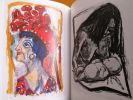Hatje Cantz. Johann-Karl Schmidt
Otto Dix.
Hatje Cantz,Germany, première édition (30 décembre 1999). In-4 relié (27,4 x 21,5 cm), jaquette illustrée, 214 pages, illustrations. Langue : Allemand, Français- 1280g. - ETAT NEUF.
Reference : 30417
ISBN : 3775708766
Bookseller's contact details
Déjà Jadis
Mme Corinne Buchta
485 av. St Lambert-L'Amarilla B.- Domaine LE PALATIN
83600 Fréjus
France
librairie.deja.jadis@orange.fr
+33 (0) 4 94 53 89 34
Payment mode

Sale conditions
Merci de votre visite.- La librairie existe depuis 1998. Vente par Internet, salons spécialisés. Vente directe possible sur rendez-vous, me contacter au préalable au 06 73 72 56 61.- Pour tout achat de livres, nous nous déplaçons dans toutes régions sur rendez-vous. Merci de nous contacter.- Commandes par mail (PAYPAL accepté), ou par téléphone (en cas d'absence, prière de laisser un message sur le répondeur). Les frais de port sont calculés selon le poids de l'ouvrage et les tarifs de la Poste (généralement de 4,70 à 7,70 euros pour un ouvrage de 1 kg, selon qu'il sera expédié au tarif lettre ou Colissimo avec suivi). Un recommandé avec assurance est ajouté pour les commandes dépassant 90 euros. Règlements : chèque, PAYPAL, virement bancaire, mandat. Les ouvrages vous sont expédiés dès la réception de votre paiement.
5 book(s) with the same title
Reference : albdb8e9b847905fe93
Loffler Fritz. Otto Dix. Leben und Werk. (Leffler Fritz Otto Dix. Life and Crea
Loffler Fritz. Otto Dix. Leben und Werk. (Leffler Fritz Otto Dix. Life and Creativity) in German. In Russian /Loffler Fritz. Otto Dix. Leben und Werk. (Leffler Frits Otto Diks. Zhizn i tvorchestvo) na nemetskom yazyke. Dresden-Dresden VEB Verlag der Kunst 1970 400s. We have thousands of titles and often several copies of each title may be available. Please feel free to contact us for a detailed description of the copies available. SKUalbdb8e9b847905fe93.
Reference : albabad7a93f0457684
Schmidt Diether. Otto Dix im Selbstbildnis / Otto Dix on self-portraits. In Ger
Schmidt Diether. Otto Dix im Selbstbildnis / Otto Dix on self-portraits. In German /Schmidt Diether / Shmidt Diter. Otto Dix im Selbstbildnis / Otto Diks na avtoportretakh. In German. Berlin. Henschelverlag Kunst und Gesellschaft. 1978. 290 p. We have thousands of titles and often several copies of each title may be available. Please feel free to contact us for a detailed description of the copies available. SKUalbabad7a93f0457684.
Reference : alb0f39b68cbc297219
Otto Dix. In Russian /Otto Dix.
Otto Dix. In Russian /Otto Dix. Stuttgart Cantz 1989. 357s. We have thousands of titles and often several copies of each title may be available. Please feel free to contact us for a detailed description of the copies available. SKUalb0f39b68cbc297219.
L' Evangile selon Saint Matthieu - Das Matthäus-Evangelium. 19 janvier - 23 fevrier 1990. Goethe Institut- Lyon. Stiftung Otto Dix Vaduz. "Dix et la religion" par Frotz Löffler.
Lyon, Musée de l'Imprimerie, in-4, broché, 37p. Ex-dono sur la page de faux-titre. Bon état.
OTTO DIX 1891-1969.
Palais des Beaux-Arts, Buxelles, 1985.31 x 24 cm, 180 pp. Broché, en bon état. Catalogue d'exposition.
 Write to the booksellers
Write to the booksellers




